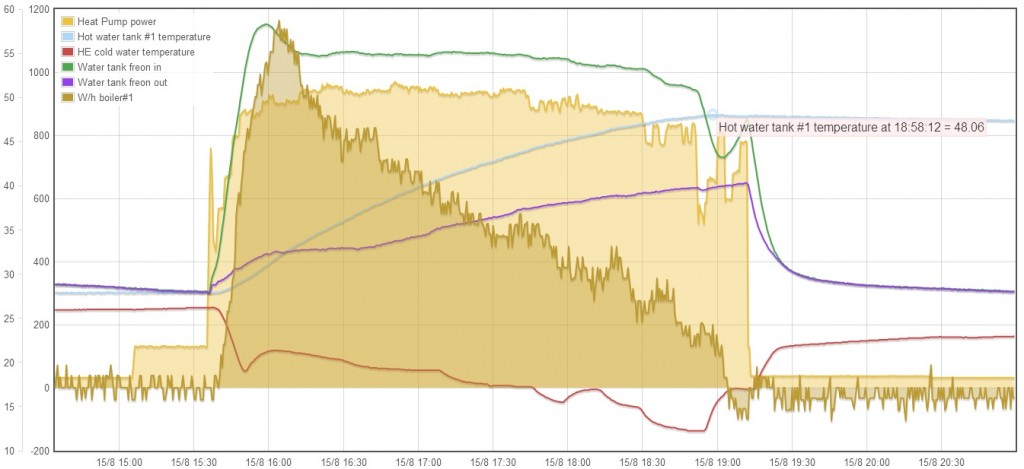Tricky blog post title, mostly true, but as you know there is no such thing as free lunch 😉 Anyway, those of you following my blog know that I have a Daikin air-to-air heat pump hacked into air-to-water solution for my place. As a bonus I get domestic hot water for both heating and cooling modes by having the refrigerant pass by a heat exchange tube in my domestic hot water tank before it reaches the reversing valve. The hack is especially interesting in cooling mode as instead of dumping the heat in the outside environment, most of it gets captured in the water tank. So you get two rabbits with one shot, house is cooled and hot water tank gets hot.
This summer hasn’t been so hot, I didn’t use the cooling mode until few days ago. I wanted to share my measurements, below is an interesting chart for the few hours I had it running:
The brownish fill shows the momentary power, calculated on the base of temperature increase of a fixed water volume. You can see that it starts pretty sharp and slowly degrades, this is because condensation in the hot water tank is most efficient while the water is relatively cold. After certain point, the refrigerant simply passes on without change of state.
The orange fill shows the power consumption, it is an inverter heat pump so it can vary. Most of the time it is around 900W, which is pretty good for cooling the whole house (and heating the water tank) given that a toaster uses that much power.

The outer wall of the Fuzhou Dalijiacheng Building is densely covered with air conditioner compressor units, the entire building’s outer wall having over 500 air conditioning compressor units attached in total and still increasing, and has been called the most “Air Conditioner Wall” in Fuzhou history by city residents.
I can imagine the amount of heat being dumped in the environment globally rather than being recuperated


Hi Martin,
interesting post as usual.
Would you mind sharing how many square meters are you heating/cooling, with how many splits (if any) and what kind of insulation you used in your house ?
The heated/cooled area is ~180m2. I have fan coils in the rooms, kitchen and bathooms use underfloor heating pipes. Insulation is pretty heavy, I have been very much inspired by the ‘passive house’ concept. Walls are 30cm Ytong blocks with 5cm BASF’s “neopor” graphite enhanced insulation on the outside and up to 20cm mineral wool on the inside plus bunch of other ‘small’ tricks to make best use of energy.
Hi,
Great topic – I was wondering how you “cheated” on the elekctronics of Daikin Air2Air to work well with water heat source – could you share bit more (pictures welcome) how to do it?
I’ve been thinking about the same idea – would be great to see how you solved it.
Thanks.
Ok found another post where you explain it. Would it be as easy to convert to water-water system?
yes, several members of a local forum have done this and report excellent results, but it is more tricky in terms of setup. Check it out here, you can use google translate to make rough sense of the writing: http://www.napravisam.bg/forum/viewtopic.php?f=10&t=35734
Great – thanks for hint.
Why did you decide for Daikin (I know it’s top of the range manufacturer)?